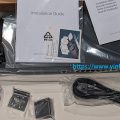Recently, I received an ethernet card for free. It is a sample. TP-link TX401, 10Gigabit PCIe Network Adapter. There are not many choices on the market for 10Gbe RJ45 network cards. This is, I believe, the most affordable one.
Amazon.com Link https://amzn.to/3W6x61A
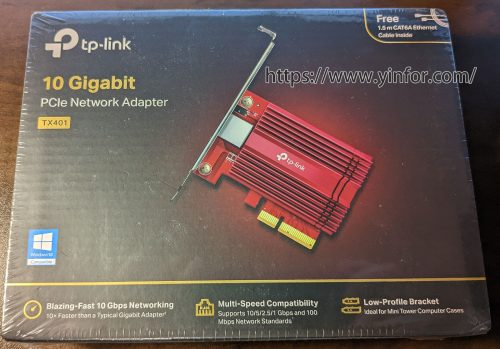
Let me open it and see what is inside.
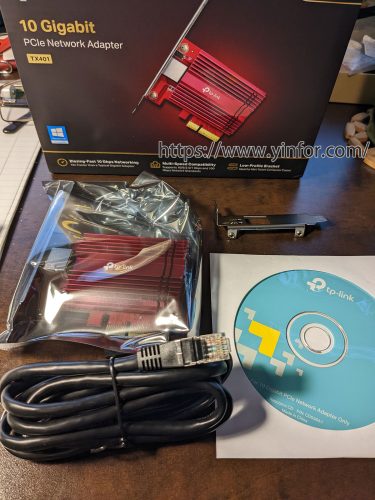
Inside the box, you can see the picture above, a TX401 adapter, a low-profile bracket, a 1.5m CAT6A cable, and one CD with driver software.
There is a big heatsink attached to the front of the card. It covers the chipset.
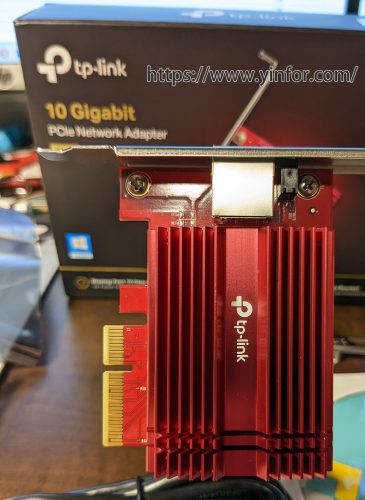
I also have the back picture for record.
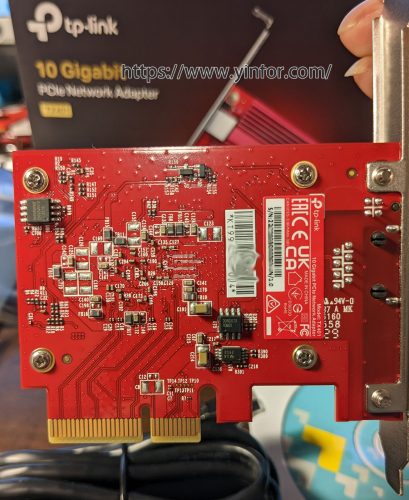
- 10 Gbps PCIe Network Card: With the latest 10GBase-T Technology, TX401 delivers extreme speeds of up to 10 Gbps, which is 10× faster than typical Gigabit adapters, guaranteeing smooth data transmissions for both internet access and local data transmissions[1]
- Versatile Compatibility: With extreme speed and ultra-low latency, 10GBase-T is backwards compatible with multiple data rates (10 Gbps, 5 Gbps, 2.5 Gbps, 1 Gbps, 100 Mbps), automatically negotiating between higher and lower speed connections
- QoS: Quality of Service technology delivers prioritized performance for gamers and ensures to avoid network congestion for PC gaming
- Free CAT6A Ethernet Cable: To maximize TX401’s performance, a 1.5 m CAT6A Ethernet Cable is included—rated for up to 10 Gbps while a regular cable is only rated for 1 Gbps
- Low-Profile and Full-Height Brackets: In addition to the standard bracket, a low-profile bracket is provided for mini tower computer cases
- Comprehensive System Support – Fully compatible with Windows 11/10/8.1/8/7, Windows Servers 2019/2016/2012 R2, and Linux to meet your diverse operating system needs
- Industry leading 2-year warranty and free 24/7 technical support
I don’t have another 10Gbe device in my network, but I have 2.5Gbe network card. So, I put the 2.5Gbe adapter into a PVE system. The 10Gbe TX401 is installed in my PC, or desktop running Windows 11. Both of them connect to the 2.5G switch through CAT5e cables.
I have to say TX401 needs to install the driver coming with the CD.
Windows 11 can recognize it as a Marvell AQtion 10Gbit Network Adapter. The connection speed is 2500Mbps or 2.5G.
The version of the driver is 3.1.7.0.
I run a few commands to double-check the interface of the network in the PVE system.
root@pve:~# lshw -class network -short H/W path Device Class Description ========================================================= /0/100/1.2/0.2/0/0 eno1 network RTL8125 2.5GbE Controller /0/100/1.2/0.2/1/0 enp4s0 network RTL8111/8168/8411 PCI Express Giga
eno1 is the 2.5Gbe PCIe network adapter.
enp4s0 is the onboard gigabit ethernet port. I am not using it.
root@pve:~# ethtool eno1
Settings for eno1:
Supported ports: [ TP MII ]
Supported link modes: 10baseT/Half 10baseT/Full
100baseT/Half 100baseT/Full
1000baseT/Full
2500baseT/Full
Supported pause frame use: Symmetric Receive-only
Supports auto-negotiation: Yes
Supported FEC modes: Not reported
Advertised link modes: 10baseT/Half 10baseT/Full
100baseT/Half 100baseT/Full
1000baseT/Full
2500baseT/Full
Advertised pause frame use: Symmetric Receive-only
Advertised auto-negotiation: Yes
Advertised FEC modes: Not reported
Link partner advertised link modes: 100baseT/Half 100baseT/Full
1000baseT/Full
2500baseT/Full
Link partner advertised pause frame use: No
Link partner advertised auto-negotiation: Yes
Link partner advertised FEC modes: Not reported
Speed: 2500Mb/s
Duplex: Full
Auto-negotiation: on
master-slave cfg: preferred slave
master-slave status: slave
Port: Twisted Pair
PHYAD: 0
Transceiver: external
MDI-X: Unknown
Supports Wake-on: pumbg
Wake-on: d
Link detected: yes
I use the iperf3 to test the speed between two hosts through a 2.5g switch with CAT5e cables. I did multiple tests, almost in the same range.
$ iperf3 -c 192.168.100.4 Connecting to host 192.168.100.4, port 5201 [ 4] local 192.168.100.147 port 11221 connected to 192.168.100.4 port 5201 [ ID] Interval Transfer Bandwidth [ 4] 0.00-1.00 sec 282 MBytes 2.37 Gbits/sec [ 4] 1.00-2.00 sec 283 MBytes 2.37 Gbits/sec [ 4] 2.00-3.00 sec 283 MBytes 2.37 Gbits/sec [ 4] 3.00-4.00 sec 283 MBytes 2.37 Gbits/sec [ 4] 4.00-5.00 sec 283 MBytes 2.37 Gbits/sec [ 4] 5.00-6.00 sec 283 MBytes 2.37 Gbits/sec [ 4] 6.00-7.00 sec 283 MBytes 2.37 Gbits/sec [ 4] 7.00-8.00 sec 282 MBytes 2.37 Gbits/sec [ 4] 8.00-9.00 sec 283 MBytes 2.37 Gbits/sec [ 4] 9.00-10.00 sec 282 MBytes 2.36 Gbits/sec - - - - - - - - - - - - - - - - - - - - - - - - - [ ID] Interval Transfer Bandwidth [ 4] 0.00-10.00 sec 2.76 GBytes 2.37 Gbits/sec sender [ 4] 0.00-10.00 sec 2.76 GBytes 2.37 Gbits/sec receiver iperf Done.
I can tell the TX401 card is great. At least in the 2.5G connection speed, it meets my expectation.
I have a plan, If I have another TX401 adapter, I can do a Peer to Peer test for 10G speed. Or, if I have an SFP+ network card and a DAC cable to connect one host to the switch. An SFP+ to RJ45 module in my switch SFP+ port, I can test the 10G speed too.
OK, for now, my 2.5G speed test on the TP-Link TX401 is done here. If you planning to make your 10Gigabits network in the future, I recommend TX401 .
List of the test equipment:
